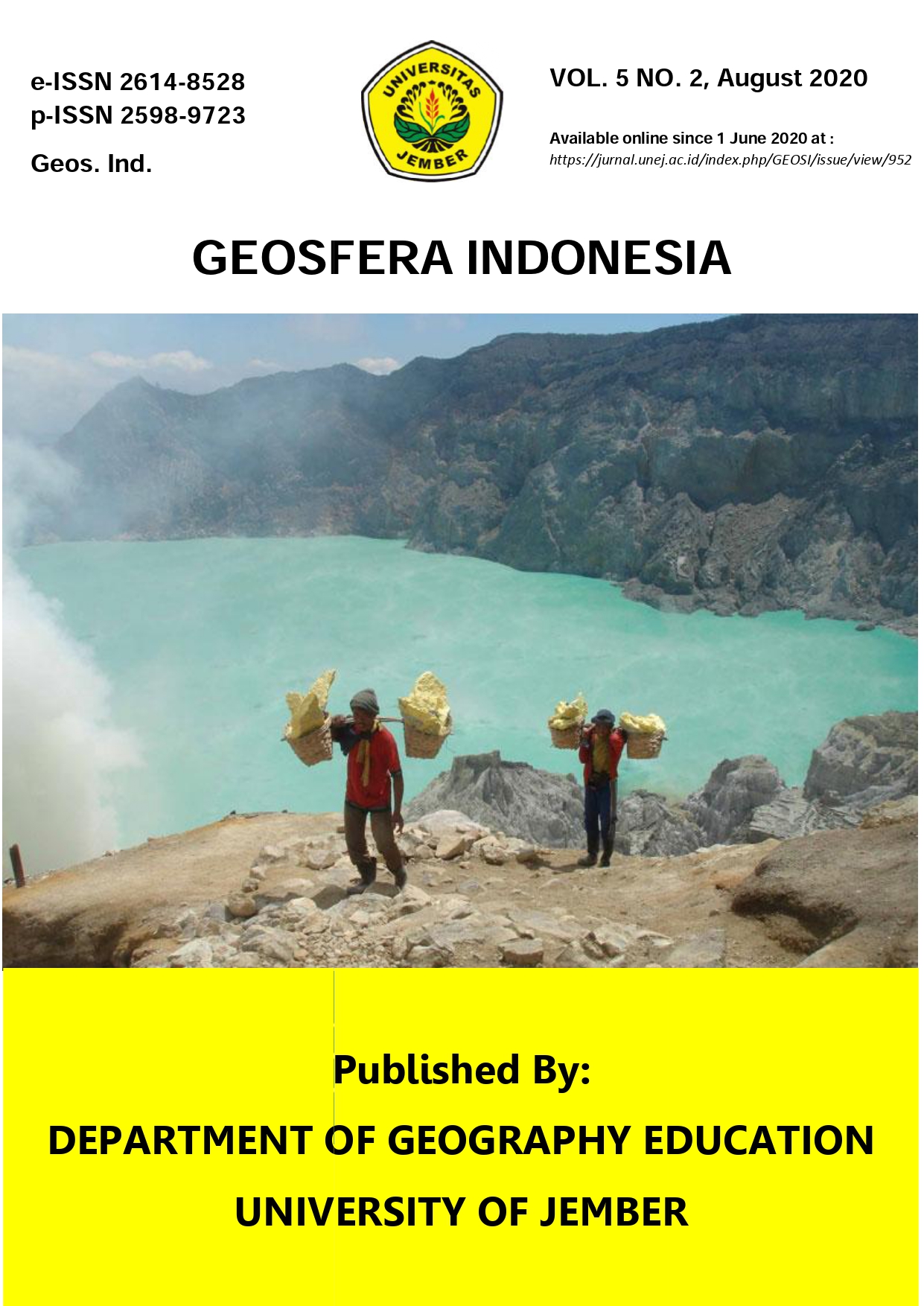Building Density Level of Urban Slum Area in Jakarta
DOI:
https://doi.org/10.19184/geosi.v5i2.18547Keywords:
Slums; City Planning; Jakarta; Dasawisma Census; Cluster and Outlier Analysis; Geographic Information SystemAbstract
Currently, the number of urban residents is increasing and some of the urban population live in slum areas. Therefore, identifying the characteristics of slum areas has become crucial. This study aimed to identify more specific slum locations in Jakarta through the pattern of building densities analysis between case studies of neighborhoods association (RT) in 15 hamlets (RW) that classified as heavy slums category. This study also attempted to determine the relation between building density levels in the slum area and Jakarta spatial detail planning. This study engaged the Cluster and Outlier Analysis (Anselin Local Moran's I) method. This study also observed socio-economic factors of citizen census data based the Dasawisma Census of Family Welfare Empowerment in 2019. The result shows that slum locations that had direct neighbors towards areas which was designated at spatial detail planning as industrial zones and ware housing areas as well as office, trade and service zones, obtained a higher level of building density compared to slum locations that secured neighbors to areas that were designated as housing zones. High economic opportunities provided attraction and affected the growth of slum locations. The results also reveal that slum areas were not a concentrated population with low income and/or low education. Applying cluster and outlier modeling of building density levels of urban slums in Jakarta based on RT cluster level could reveal more specific slum locations and could identify factors that influence the differences of building density levels.
Keywords: Slums; Spatial Detail Planning; Cluster and Outlier Analysis; Geographic Information System
Copyright (c) 2020 Geosfera Indonesia Journal and Department of Geography Education, University of Jember

This work is licensed under a Creative Commons Attribution-Share A like 4.0 International License
Downloads
References
Anselin, L. (1995). Local Indicators of Spatial Association—LISA. Geographical Analysis, 27(2), 93–115. https://doi.org/10.1111/j.1538-4632.1995.tb00338.x.
Arribas-Bel, D., Garcia-López, M., & Viladecans-Marsal, E. (2019). Building(s and) cities: Delineating urban areas with a machine learning algorithm. Journal of Urban Economics, October, 103217. https://doi.org/10.1016/j.jue.2019.103217.
Badmos, O. S., Callo-Concha, D., Agbola, B., Rienow, A., Badmos, B., Greve, K., & Jürgens, C. (2020). Determinants of residential location choices by slum dwellers in Lagos megacity. Cities, 98(December 2019), 102589. https://doi.org/10.1016/j.cities.2019.102589.
Bird, J., Montebruno, P., & Regan, T. (2017). Life in a slum: Understanding living conditions in Nairobi’s slums across time and space. Oxford Review of Economic Policy, 33(3), 496–520. https://doi.org/10.1093/oxrep/grx036.
de Bellefon, M. P., Combes, P. P., Duranton, G., Gobillon, L., & Gorin, C. (2020). Delineating urban areas using building density. Journal of Urban Economics, November 2019. https://doi.org/10.1016/j.jue.2019.103226.
Duah, E., & Bugri, J. T. (2016). Feasibility of Slum Redevelopment in Ghana: The Regenerative Approach. Sociology and Anthropology, 4(11), 987–1002. https://doi.org/10.13189/sa.2016.041106.
Elrayies, G. M. (2016). Rethinking Slums: An Approach for Slums Development towards Sustainability. Journal of Sustainable Development, 9(6), 225. https://doi.org/10.5539/jsd.v9n6p225.
Friesen, J., Rausch, L., Pelz, P., & Fürnkranz, J. (2018). Determining Factors for Slum Growth with Predictive Data Mining Methods. Urban Science, 2(3), 81. https://doi.org/10.3390/urbansci2030081.
Kuffer, M., Pfeffer, K., & Sliuzas, R. (2016). Slums from space-15 years of slum mapping using remote sensing. Remote Sensing, 8(6). https://doi.org/10.3390/rs8060455.
Leonita, G., Kuffer, M., Sliuzas, R., & Persello, C. (2018). Machine learning-based slum mapping in support of slum upgrading programs: The case of Bandung City, Indonesia. Remote Sensing, 10(10). https://doi.org/10.3390/rs10101522.
Ministry of Public Works and Indonesian Public Housing-PUPR. (2016). Regulation Number 02/PRT/M/2016: Improving the Quality of Slum Housing and Areas. https://jdih.pu.go.id/internal/assets/assets/produk/PermenPUPR/2016/01/PermenPUPR02-2016.zip.
Nakamura, S. (2016). Revealing invisible rules in slums: The nexus between perceived tenure security and housing investment. Habitat International, 53, 151–162. https://doi.org/10.1016/j.habitatint.2015.11.029.
Pratomo, J., Kuffer, M., Martinez, J., & Kohli, D. (2017). Coupling uncertainties with accuracy assessment in object-based slum detections, case study: Jakarta, Indonesia. Remote Sensing, 9(11). https://doi.org/10.3390/rs9111164.
Prianto, A. L., & Amalia, A. A. (2019). Combatting Slums, Suistaining Poverty: Dynamic Urban Governance in Makassar, Indonesia. Otoritas : Jurnal Ilmu Pemerintahan, 9(1), 28–41. https://doi.org/10.26618/ojip.v9i1.2008.
Ray, B. (2017). Quality of life in selected slums of Kolkata: a step forward in the era of pseudo-urbanisation. Local Environment, 22(3), 365–387. https://doi.org/10.1080/13549839.2016.1205571.
Roy, D., & Lees, M. (2020). Understanding resilience in slums using an agent-based model. Computers, Environment and Urban Systems, 80(April 2019). https://doi.org/10.1016/j.compenvurbsys.2019.101458.
Roy, D., Lees, M. H., Palavalli, B., Pfeffer, K., & Sloot, M. A. P. (2014). The emergence of slums: A contemporary view on simulation models. Environmental Modelling and Software, 59(2014), 76–90. https://doi.org/10.1016/j.envsoft.2014.05.004.
Roy, D., Palavalli, B., Menon, N., King, R., Pfeffer, K., Lees, M., & Sloot, P. M. A. (2018). Survey-based socio-economic data from slums in Bangalore, India. Scientific Data, 5, 1–9. https://doi.org/10.1038/sdata.2017.200.
Saika B. A. S., & Matsuyuki, M. (2017). Applicability of Land Sharing Scheme to Korail Slum, Dhaka, Bangladesh. Urban and Regional Planning Review, 4(0), 151–167. https://doi.org/10.14398/urpr.4.151.
Takyi, S. A., Amponsah, O., Yeboah, A. S., & Mantey, E. (2020). Locational analysis of slums and the effects of slum dweller’s activities on the social, economic and ecological facets of the city: insights from Kumasi in Ghana. GeoJournal, 2. https://doi.org/10.1007/s10708-020-10196-2.
Uddin, N. (2018). Assessing urban sustainability of slum settlements in Bangladesh: Evidence from Chittagong city. Journal of Urban Management, 7(1), 32–42. https://doi.org/10.1016/j.jum.2018.03.002.
UNâ€Habitat. (2004). The Challenge of Slums: Global Report on Human Settlements 200320043 The Challenge of Slums: Global Report on Human Settlements 2003 . London: Earthscan 2003. 310 pp., ISBN: 1844070379 £22.50 . Management of Environmental Quality: An International Journal, 15(3). https://doi.org/10.1108/meq.2004.15.3.337.3.
United Nations. (2019). The sustainable development goals report 2019. In United Nations publication issued by the Department of Economic and Social Affairs. https://undocs.org/E/2019/68.
Wati, A. (2018). Keterikatan Tempat Bermukim Pada Permukiman Kumuh Di Manggarai, Jakarta-Selatan. Jurnal Ilmiah Desain & Konstruksi, 17(1), 1-10.
Wijaya, A., Ardalia, F., & Dewi, E. P. (2019). Pemanfaatan Ruang Komunal Pada Kawasan Permukiman Kumuh Perkotaan Di Manggarai Jakarta Selatan. IKRA-ITH TEKNOLOGI: Jurnal Sains & Teknologi, 3(2), 17-26.
Zain, D. P., Salman, D., & Baja, S. (2018). Model of slum area management based on socio-spatial approach. The case of Baubau City, Indonesia. Journal of Settlements and Spatial Planning, 9(2), 103–115. https://doi.org/10.24193/JSSP.2018.2.03.



